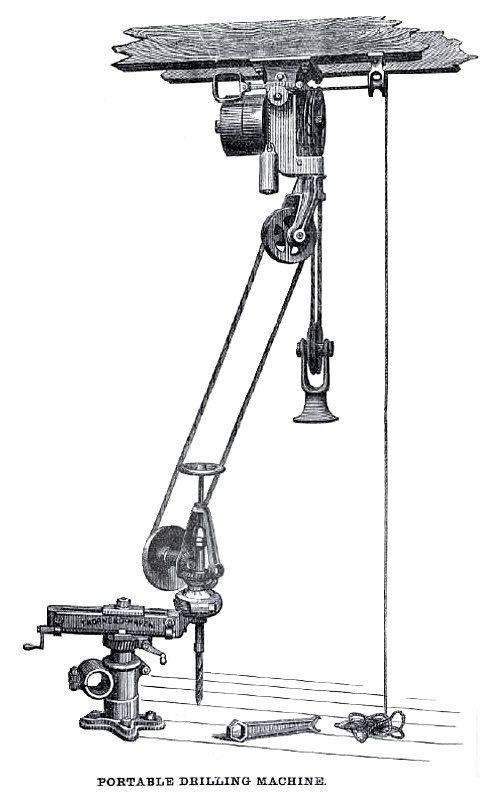|
Title: |
1871 Article-Thorne & De Haven, Portable Drilling Machine |
|
Source: |
The Journal of the Franklin Institute, V62 #5, Nov 1871, pg. 290 |
|
Insert Date: |
3/9/2013 8:01:38 PM |
Portable Drilling Machines.
Messrs. Thorne & De Haven (Twenty-third and Cherry streets, Philadelphia) are building Portable Radial Drilling Machines, which have all the advantages of Radial Drills, and at the same time can be bolted to heavy parts of machinery or iron work, with much greater facility than a ratchet-brace can be rigged up for hand-drilling, and can be driven by power in any position, no matter where the work may be. They are adapted to drilling holes in -all pieces of machinery which are inconvenient to move, or which cannot be readily adjusted under stationary drilling machines. They afford a great saving of time where several holes are to be drilled in the same piece, even where a drill-press could be used, in consequence of the ease and accuracy of adjustment gained by the screw and worm movements of the radial arm carrying the gearing and drill-spindle. They are specially needed in marine, locomotive and all erecting-shops, and in yards adjoining shops, on columns, architectural work, water-mains, gas-works, iron ships, iron bridges, &c.
The accompanying cut is a true representation of Messrs. Thorne & De Haven's smallest size machine, which, with the assistance of the following description, can be easily understood.
The counter-hanger is stationary, receiving power from the line-shaft of the shop through a flat belt on "fast-and-loose" pulleys, in the usual way. The power is transmitted to the drilling machine, in any direction and to any distance, by means of a round belt passing over "idler" pulleys, held in a frame, which rotates on a hollow stud, through which the pulling side of the belt passes. A weighted "idler" pulley hangs on the "slack" side of the belt, and maintains the tension, permitting the distance of the drilling machine to be varied at will. When the rise and fall of the weighted "idler" does not give sufficient variation of distance, additional lengths of belt can be inserted by means of the hook couplings used, and any distance thus obtained. The drilling-machine itself is a complete Radial Drill.
The height of its post can be varied to suit different lengths of drills and chucks; the radial arm is travelled by a screw and rotated by a worm and tangent wheel; the cone pulley has four steps for four speeds; the drill spindle can be set to an angle with the base in any direction. The base of the machine can be bolted to the work, either vertically, horizontally, or in any plane. It can be used to drill parallel with its own base, by holding the post in the clamp-bearing on side of base.
Patent #’s 113,113 & 114,229. |
|
 1871 Thorne & De Haven, Portable Drilling Machine
1871 Thorne & De Haven, Portable Drilling Machine
|
|